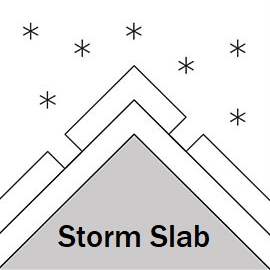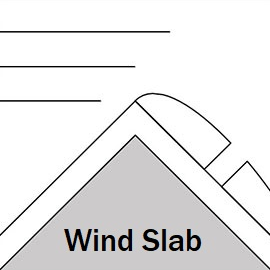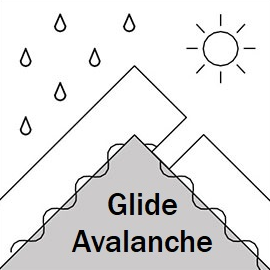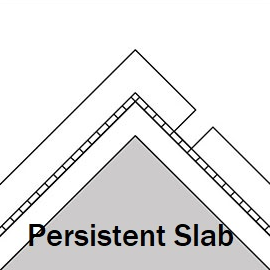Gudauri
Natural avalanches are possible, human-triggered avalanches are likely. Small avalanches in many areas, or large avalanches in specific areas, or very large avalanches in isolated areas.
20 - 50 cm of new snow creates fresh storm slabs in the alpine and possibly sub-alpine. Moderate winds may also from reactive wind slabs in the high alpine. There were reports of surface hoar, which has likely been destroyed by warm weather and winds. However, there is a chance the new snow will fall on unstable surface hoar in some isolated spots. Remain cautious at high elevations where the snowpack is rocky, shallow and steep, as the recent cold snap has promoted facet (weak layer) formation there.
Forecast issued at: 22 January 2024 01:00
Forecast valid until: 24 January 2024 01:00
Forecaster: Peter S
High Alpine
> 2600m
3 Considerable
Dangerous avalanche conditions. Careful snowpack evaluation, cautious route-finding and conservative decision-making essential.
Alpine
2000m - 2600m
2 Moderate
Heightened avalanche conditions on specific terrain features. Evaluate snow and terrain carefully; identify features of concern.
Sub Alpine
< 2000m
2 Moderate
Heightened avalanche conditions on specific terrain features. Evaluate snow and terrain carefully; identify features of concern.
Avalanche Problems
Storm Slab

New snow is on the way! The amount of snow is a bit uncertain, with forecasts predicting from 20 - 50 cm by the end of the Monday. If the new snow amounts are in the upper range of this spectrum, we are looking at a new, widespread storm snow (= new snow) problem.
| Sensitivity | The specific avalanche problem type is reactive to human rider triggers. Easy to trigger with ski cut. |
| Distribution | Many locations. Evidence for instabilities is frequently found, in many locations. |
| Time of Day | All day |
| Trend | Deteriorating |
| Confidence | Moderate |
Wind Slab

While winds are forecasted to be low to moderate, they may be strong enough to create fresh wind-slab on north-west, north and north-east aspects. Watch for winds strong enough to make small trees and bushes move, as such wind speeds are very efficient for creating localized wind-slabs.
| Sensitivity | The specific avalanche problem type is reactive to human rider triggers. Easy to trigger with ski cut. |
| Distribution | Specific areas, with common characteristics. Evidence for instabilities exists, but it is not obvious and finding it requires careful observations. |
| Time of Day | Afternoon |
| Trend | Deteriorating |
| Confidence | Moderate |
Glide

With mild day time temperatures, we expect glide cracks and full-depth glide avalanches to remain active. They are common around the Gudauri region, and will be with us for the rest of the season. These avalanches can release randomly on all aspects, even at night, although rapid warming makes them more likely. Do not stop under steep areas if there are cracks above you. Remember that new snow or wind-drifting can disguise these cracks.
| Sensitivity | The specific avalanche problem type is difficult to trigger with a human rider. |
| Distribution | A few, isolated locations; evidence for instabilities is rare and hard to find. |
| Time of Day | All day |
| Trend | No change |
| Confidence | Moderate |
Persistent Slab

Weak layers associated with melt-freeze crusts or density changes have been found in a couple of spots recently, and cold temperatures have made the layers weaker. These weaknesses probably need a large load to set them off, but with new snow adding weight, watch this space! Probably only found in isolated areas, although there is still uncertainty - we need more information, so please let us know what you find out there.
| Sensitivity | The specific avalanche problem type is difficult to trigger with a human rider. |
| Distribution | A few, isolated locations; evidence for instabilities is rare and hard to find. |
| Time of Day | All day |
| Trend | No change |
| Confidence | Moderate |
Recent Avalanches and Snowpack
Avalanche Activity:
18th January - New size 2 Glide slab seen in Khada valley, E aspect, 2200m?
16th January - Skier triggered size 1 wind slab, 2500m, NE aspect Milioni valley, 20cm deep, 20m wide, ran 5m off a steep bank.
Snowpack: 20-50 cm of new snow with low to moderate winds are expected to fall on a generally-well consolidated snow pack. Recent cold temperatures have weakened some snow layers above 2000m, and feathery surface hoar crystals have been seen in some shady areas in the alpine zone. Most surface hoar has likely been destroyed by mild temperatures on 21 Feb or by winds, but the surface hoar may have survived in isolated places, which will be covered by new snow - check your slope before you drop. Weak, faceted snow can be found in shallow rocky areas near ridges at higher elevations, and a melt-freeze crust with facets above it was found on an E aspect at 2970m. Whumphing was reported from Lomisa area, NE aspect, 2100 m.
Check recent profiles at snowpilot.org
Weather
Mild temperatures with not much wind on Jan 21st, producing moist snow below 2600m.
Monday 22nd: up to 30cm snow (if we're lucky!) and maybe more at higher elevations. Light to moderate south winds through Monday and Tuesday. Freezing level 1400 Monday lowering to 450 (!) Tuesday.
Disclaimer
Our avalanche forecasters are internationally qualified and experienced professionals, and data is provided by skilled observers. We encourage you to make your own observations and decisions, without relying solely on our forecast, since any forecast is a generalised 'best guess', and in certain cases it might be inaccurate. We can not be held liable for any actions you take in the backcountry that may result in injury, loss or death.